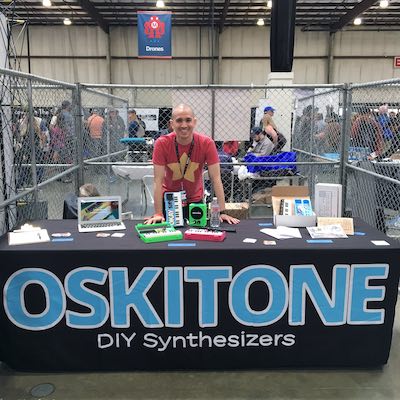POLY555 Synth
The POLY555 is a 20 key, analog, polyphonic square-wave synthesizer based on the 555 timer, an ubiquitous but ancient IC chip.
 Years ago, I put out an instrument kit called the OKAY Synth. It was monophonic (that is, could only play one note at a time) and used one 555 timer chip as its one voice. (For those unfamiliar to electronics, the 555 has been around FOREVER, and a simple blinker circuit that uses it is a very typical first project for a budding hobbyist.)
Years ago, I put out an instrument kit called the OKAY Synth. It was monophonic (that is, could only play one note at a time) and used one 555 timer chip as its one voice. (For those unfamiliar to electronics, the 555 has been around FOREVER, and a simple blinker circuit that uses it is a very typical first project for a budding hobbyist.)The first question I always got when showing it to people was "How can it play more than one note at a time?" (aka polyphony). Now, there are a lot of ways to make an electronic instrument that does that, but the pettiest way was to multiply the 555 chips in it.
And that's exactly what the POLY555 is. It's 20 555 timers, each powered by and tuned to a respective piano key, and mixed into a 386 amplifier. They're lovingly displayed under a plexiglass window in a 3D-printed enclosure. It's not the most convenient or practical of musical instruments, but for folks who get it, it is immensely satisfying.
Its PCB was designed in KiCad, and everything else was coded in OpenSCAD and is 3D-printed.
Wanna make your own? It's available as a kit (both with and without the 3D-printed parts for folks with access to a 3D printer), and it's fully Open Source, from the PCB to the 3D models to the code that makes em.
You can read a lot more about its design and history here: https://blog.tommy.sh/posts/poly555-synth/
Oskitone
: Studio

Hi! My name is Tommy and I'm a software engineer from the Bay Area. I run Oskitone, a one-man musical instrument studio where I design and sell DIY synthesizer kits.
My projects have appeared in Make: Magazine, Hackspace, and IRL at the Center for New Music.
Someday I'd also like to run a hot dog stand. A man can dream!
My projects have appeared in Make: Magazine, Hackspace, and IRL at the Center for New Music.
Someday I'd also like to run a hot dog stand. A man can dream!
Connect with Oskitone
How you can help me:
Get social on IG/Twitter/github: @oskitone
Subscribe to the mailing list: oskitone.com/mailing-list
Buy from the Oskitone store: oskitone.com
Get social on IG/Twitter/github: @oskitone
Subscribe to the mailing list: oskitone.com/mailing-list
Buy from the Oskitone store: oskitone.com